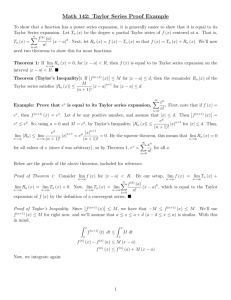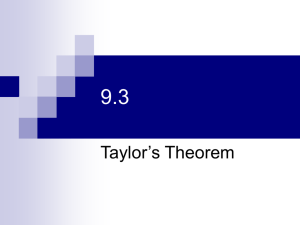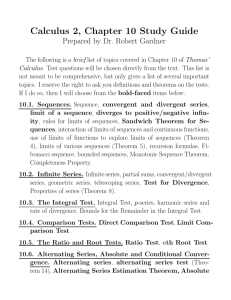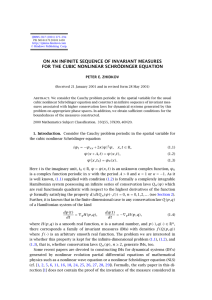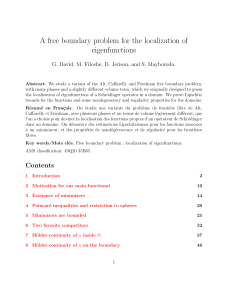Lecture 12: Formal Taylor Series For the last several lectures, we
advertisement
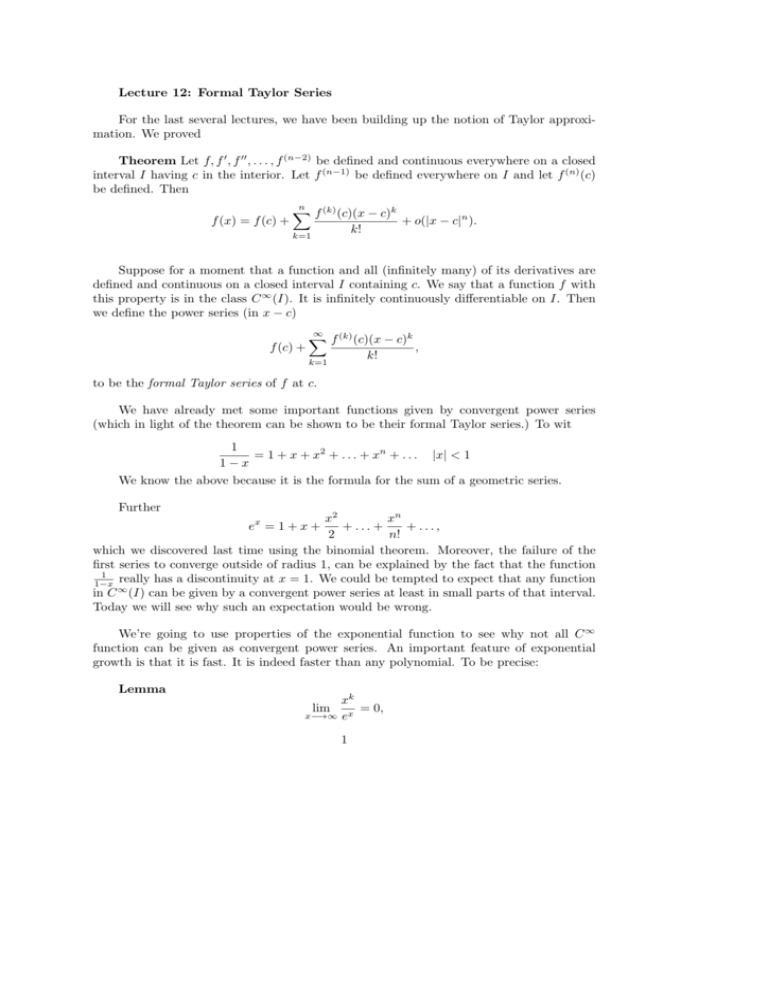
Lecture 12: Formal Taylor Series
For the last several lectures, we have been building up the notion of Taylor approximation. We proved
Theorem Let f, f 0 , f 00 , . . . , f (n−2) be defined and continuous everywhere on a closed
interval I having c in the interior. Let f (n−1) be defined everywhere on I and let f (n) (c)
be defined. Then
f (x) = f (c) +
n
X
f (k) (c)(x − c)k
k!
k=1
+ o(|x − c|n ).
Suppose for a moment that a function and all (infinitely many) of its derivatives are
defined and continuous on a closed interval I containing c. We say that a function f with
this property is in the class C ∞ (I). It is infinitely continuously differentiable on I. Then
we define the power series (in x − c)
f (c) +
∞
X
f (k) (c)(x − c)k
k!
k=1
,
to be the formal Taylor series of f at c.
We have already met some important functions given by convergent power series
(which in light of the theorem can be shown to be their formal Taylor series.) To wit
1
= 1 + x + x2 + . . . + xn + . . . |x| < 1
1−x
We know the above because it is the formula for the sum of a geometric series.
Further
x2
xn
+ ... +
+ ...,
2
n!
which we discovered last time using the binomial theorem. Moreover, the failure of the
first series to converge outside of radius 1, can be explained by the fact that the function
1
1−x really has a discontinuity at x = 1. We could be tempted to expect that any function
in C ∞ (I) can be given by a convergent power series at least in small parts of that interval.
Today we will see why such an expectation would be wrong.
ex = 1 + x +
We’re going to use properties of the exponential function to see why not all C ∞
function can be given as convergent power series. An important feature of exponential
growth is that it is fast. It is indeed faster than any polynomial. To be precise:
Lemma
xk
= 0,
x−→∞ ex
lim
1
for all natural numbers k.
The Lemma is usually proven using L’Hopital’s rule, which have not yet developed.
But the fact is much more visceral and basic.
To prove the lemma, we first study this limit for x restricted to natural numbers.
That is we study
nk
.
en
Now the denominator is rather easily understood as a product of n copies of e.
en = ee . . . e.
To properly compare it to nk , we should express nk as a product of n terms. We can
readily do this by setting up a telescoping product.
nk = 1(
2k 3k
nk
)(
)
.
.
.
(
).
1k 2k
(n − 1)k
Now it is rather easy to understand the limit of the factors of nk , precisely to show
nk
= 1.
n−→∞ (n − 1)k
lim
Using the definition of the limit, we see that there is N > 0 so that when n > N , we
have
nk
e
≤
.
(n − 1)k
2
Hence we get
k
nk
1 2k
0 ≤ n = 1 ...
e
e e
nk
(n−1)k
e
1
≤ C( )n−N .
2
Here C is the product of the first N factors and we have just used that the rest is less than
1
2.
Now we just apply the squeeze theorem. To control non-integer x, we assume n <
x < n + 1 and see
nk
xk
(n + 1)k
≤
≤
.
en+1
ex
en
We apply the squeeze theorem again.
So what did any of that have to do with the failure of formal Taylor series to converge
to their function.
We introduce a very special function:
2
f (x) =
1
e − x2
0
if x > 0;
if x ≤ 0.
This f is a piecewise defined function, and so we can expect there to be problems
either wih existence or continuity of the derivatives at x = 0. But let’s see what happens.
1
2
d − 12
(e x ) = ( 3 )e− x2 .
dx
x
1
1
d2 − 12
d 2
2
(e x ) = [ ( 3 )]e− x2 + ( 3 )2 e− x2 .
2
dx
dx x
x
And so on. But in general
dn − 12
1 − 12
x ) = p (
(e
)e x ,
n
dxn
x
with pn a polynomial. We use the change of variables y =
1
x
to calculate
1
1
pn (y)
= 0.
lim pn ( )e− x2 = lim
2
y−→∞ ey
x−→0
x
But what about right at 0? Are the derivatives of f defined?
1
Claim e− x2 is o(x).
Proof of claim
1
e− h2
y
lim
= lim y2 = 0.
y−→∞
h−→0
h
e
Hence f 0 (0) = 0 by the claim and the definition of the derivative. We have shown that
f has a continuous derivative everywhere. Proceeding by induction to prove that f (n) (x)
is continuous, we observe that f (n−1) (x) is o(x) in the same way, obtaining f ( n)(x) = 0.
Putting together all we have learned about f , we obtain
Theorem Our special function f is in the class C ∞ (R), and all the derivatives f (n) (0)
are equal to zero. Thus the formal Taylor series of f at 0 is identically 0.
Thus taking the formal power series of f at 0 throws away all information about f ,
Once a mathematical hope fails, it tends to fail catastrophically. Having discovered
this single weird function f , we can use it to engineer a whole menagerie of weird function,
which we proceed to do.
Theorem For any closed interval [a, b], there is a function f[a,b] which is of the class
C ∞ (R) so that f[a,b] (x) > 0 for x ∈ (a, b) but f (x) = 0 otherwise.
3
Proof Define
f[a,b] (x) = f (x − a)f (b − x).
Corollary For every interval [−, ], there is f so that f (x) = 1 if x ∈ (−, ), so
that 0 < f (x) ≤ 1 if x ∈ (−2, 2) and f (x) = 0 otherwise.
Proof We define
f (x) =
f[−2,2] (x)
.
f[−2,2] (x) + f[−3,−] (x) + f[,3] (x)
We will conclude with an interesting relationship between C ∞ (R) functions and formal
power series. We recall that there are plenty of power series whose radius of convergence
is 0.
Example
Consider the power series
∞
X
n!xn .
n=0
It has radius of convergence 0. We can see this since the ratios of consecutive terms are
nx. For any fixed x 6= 0, these tend to infinity.
We now state and sketch the proof of a theorem of Borel which says that nonetheless,
every power series is the formal Taylor series of some C ∞ (R) function.
P∞
Theorem (Borel) Let n=0 an xn be some power series. (Any power series whatsoever.) There is a C ∞ (R) function g which has this series as its Taylor series at 0.
Sketch of Proof Pick {k } a fast decreasing sequence of positive real numbers. (How
fast will depend on the sequence {an }.
Define
∞
X
ak xk fk (x).
g(x) =
k=0
Thus the kth term of the series really is exactly ak xk for x sufficiently small. (But
how small will depend on k.) On the other hand, for each non-zero x, only finitely many
terms are non-zero, so the sum converges there. We simply choose the sequence {k } small
enough that
n
X
ak xk = o(xn ),
g(x) −
k=0
for every n.
4






